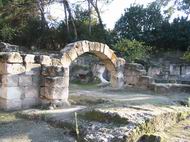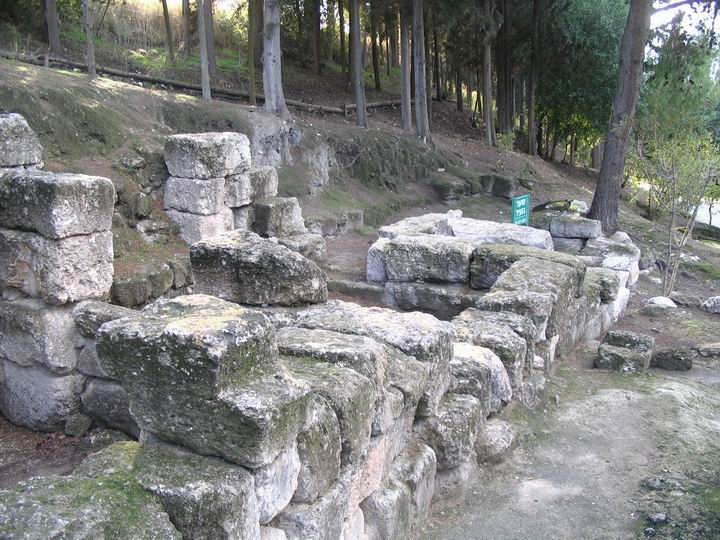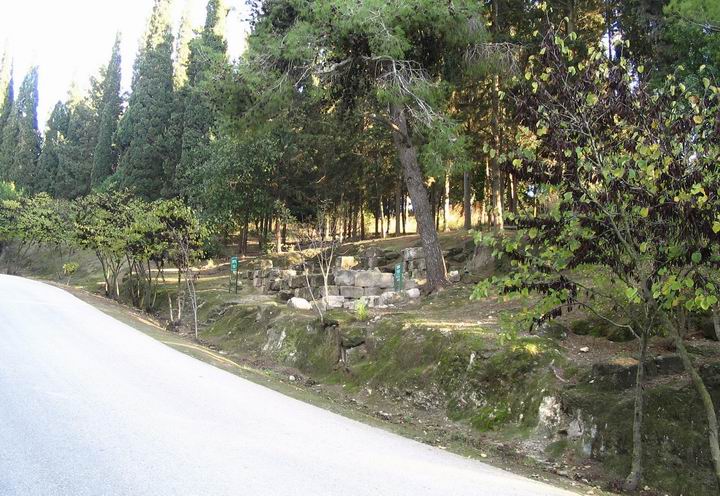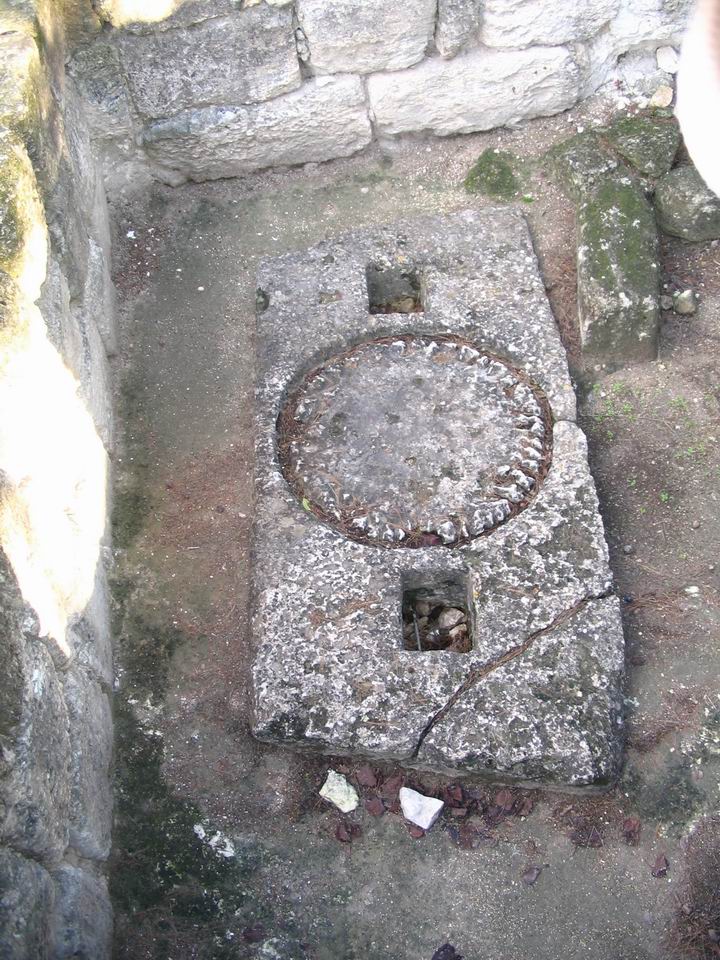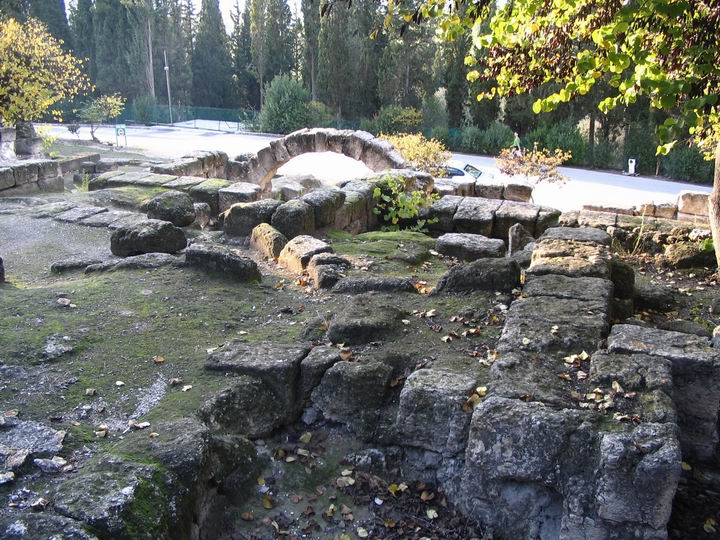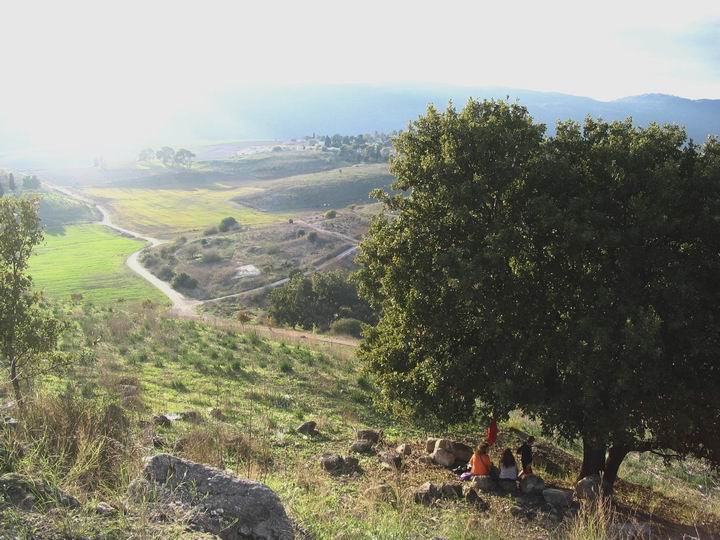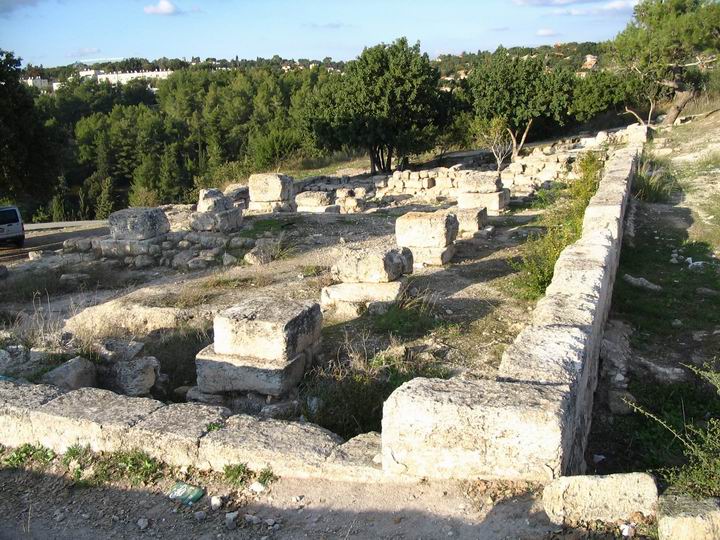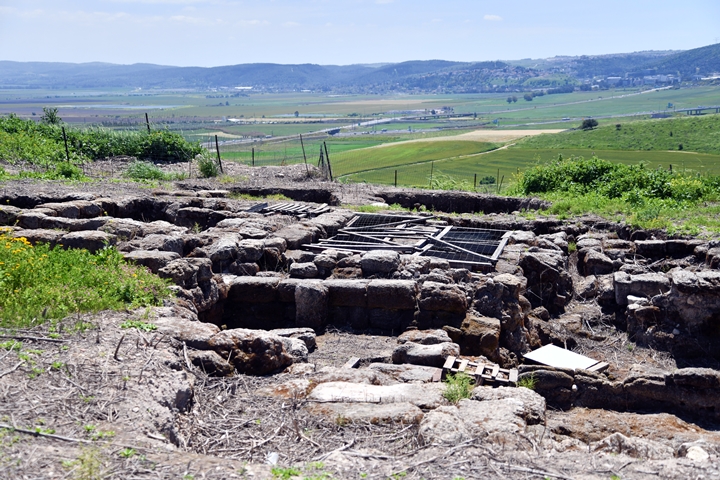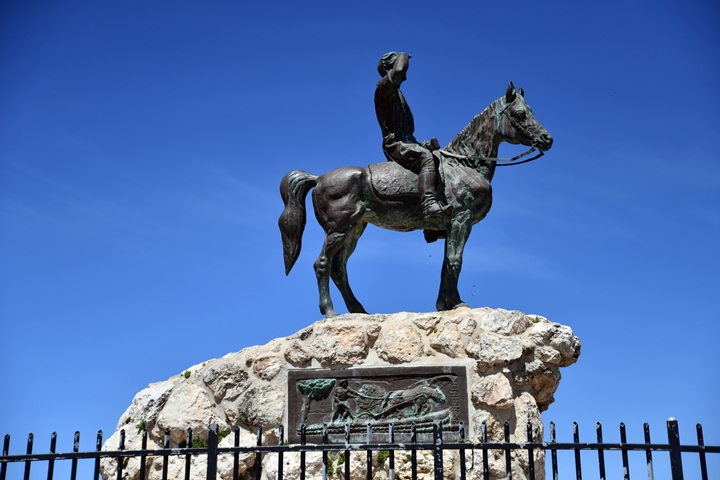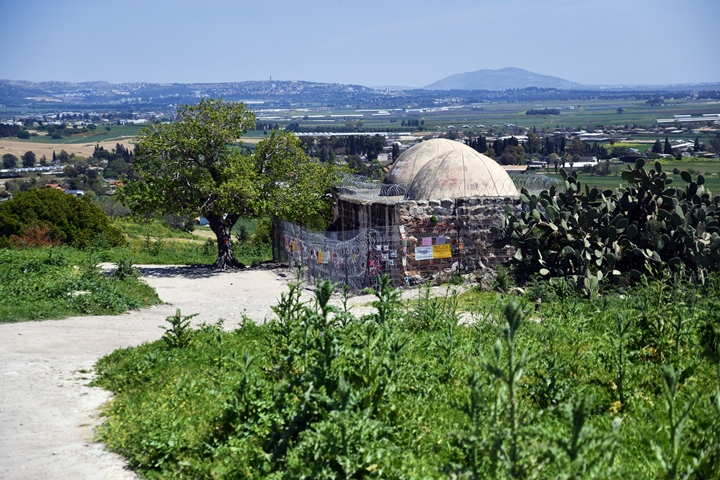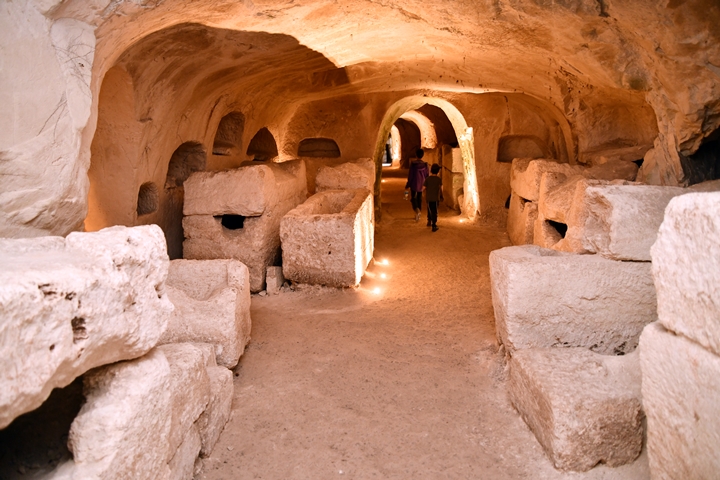In Beit Shearim are ruins of a Hellenistic and Roman city. It is a famous archaeological site, due to its remarkable necropolis.
Home > Sites > Yizreel Valley > Beit Shearim (Besara)
Contents:
Background
Location
History
Photos
* Aerial
* City Gate
* Synagogue
* West Side
* Alexander Zaid
* Sheik Tomb
* Catacombs
References
Etymology
Links
Background:
Beit She’arim is an ancient Jewish archaeological site and a UNESCO World Heritage Site located in northern Israel, about 20 kilometers east of Haifa.
It was a Hellenistic and Roman city, one of the most important in the area. During the Jewish revolt against the Romans, it became one of the bases for the commander, Josephus Flavius.
The site was a significant Jewish cultural and spiritual center in the 2nd to 4th centuries CE, and it was the burial place of several important Jewish figures, including Rabbi Judah HaNasi (Judah the Prince), who is credited with compiling the Mishnah, a major work of Jewish law.
The catacombs of Beit She’arim contain thousands of rock-cut tombs, many of which are decorated with elaborate and beautiful artwork, including Jewish symbols and scenes from the Hebrew Bible. The catacombs were not only used for burials but also as gathering places for the living, as evidenced by the inscriptions and graffiti found on the walls.
The site is also notable for its unique architecture, which includes an underground tomb complex, a synagogue, and a grand burial chamber with a domed ceiling.
Today, visitors to Beit She’arim can explore the catacombs and other remains of the ancient city, as well as learn about the site’s rich Jewish history and culture. The site is also surrounded by beautiful natural landscapes and offers breathtaking views of the surrounding hills and valleys.
Location:
The ruins of the village are located in the south side of Tivon, a city on the road from Haifa to Nazareth. A Kibbutz with the same name, Beit Shearim, is located 5 KM to the east. It may confuse you if you are driving from Nazareth, but the ancient site is located south to the city of Tivon. It can be reached either from the north from Tivon, or from Sede Yaakov.
There are 2 sections in Beit Shearim: the ruins of the Roman city are located on the top side, while the catacombs are located on the hillside below the hill. The catacombs are within a national park, secured behind gates, and you need to pay for the admission and visit the caves only within daytime hours.
The following aerial view shows the points of interest.
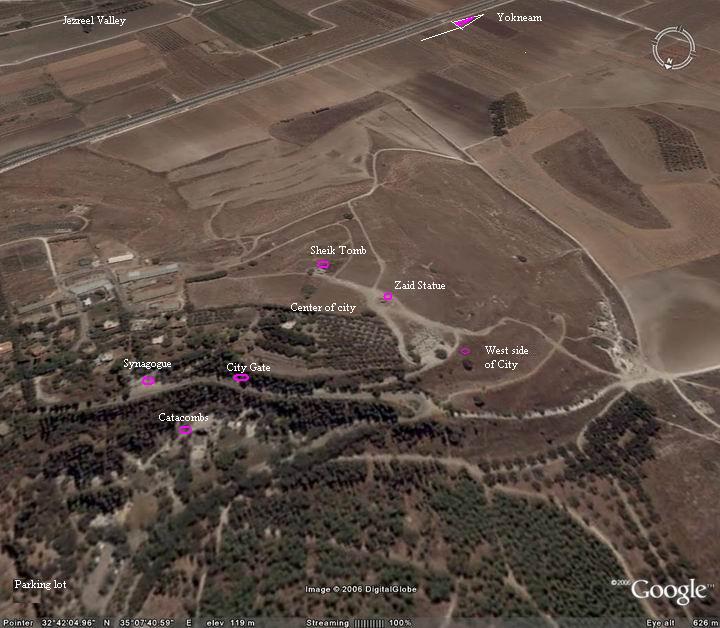
History:
The city was first inhabited in the 9th century BC. It was established during the Persian period (4-5 century BC) and the Hellenistic period (4-3 century BC). It was probably a continuation of the Biblical site to the south, Tell Kassis (Biblical Khelkat?), 2KM south west. The city was mentioned by Josephus Flavius, who described his actions during the revolt against the Romans (67/68 AD). He did not fortify the city, but confiscated the corn that was stored in the city and belonged to the sister of Agrippas II (see references below).
The city reached its peak during the 2nd and 3rd century AD, and for some time it hosted the Sanhedrin (supreme judicial body during and shortly after the Second Temple period) . After the chief of the Sanhedrin, Yehuda Hannasi, was buried in the hillside, the city became famous and many rich families buried their dead in the rock-cut necropolis.
The city was destroyed by the Roman legions during the Gallus revolt (351/2 AD). A new theory suggested that the destruction was by an earthquake that hit the area of Mt. Carmel (419). The city did not recover this destruction, and remained a small village.
In the 19th century a small Arab village, Sheik Ibrik, was located on the hill, named after the tomb of the Sheik.
Photos:
(a) Aerial View
An aerial view, captured by a quadcopter drone from the south-west side, shows the hill on which the ruins of the ancient city are located. The ancient city of Beit Shearim (Besara) is located on the summit, and was only partially excavated to date. It is open to the public, offering great views of the area.
On the left (north) corner in the background is the location of the national park of Beit Shearim, with its famous catacombs. On the right is a new section of the catacombs.
Click on the photo to view it in higher resolution…
![]() You can “fly” over the site with this drone video.
You can “fly” over the site with this drone video.
(b) City Gate
The main entrance to the city was located on the eastern side of the city. Remains of the city gate are as seen below. Most of the city is covered under the forest and the grounds around the hill, and was not yet excavated.
The next photo offers another view of the city gate. A stone paved road lead from the gate into the city.
The city’s income relied on agriculture (wheat, corn, olives and grapes) and later added grave digging (constructing the catacombs). Adjacent to the city gate are the remains of an oil press, seen below. In the base of the oil press the olives were placed in bags on top of the base, and a heavy stone pressed from above, crushing the olives, and squashing out the oil extract through the small groove on the right side, and flowed into a jar.
(c) Synagogue
Near the entrance of the ancient city stood the synagogue. In the photo below is the front side of the compound of the synagogue. From here the worshippers walked down the stairs into the Necropolis – the array of catacombs that lie just under this area on the hillside. The synagogue was 35 x 15M, and its entrance faces south (towards Jerusalem).
(d) West side
On the west side of the ancient city is a nice view of the area, with the low hills of the town of Tivon around it and mount Carmel in the background.
Families, as seen below, come here for a stroll and picnic to enjoy the scenery. The view of the rolling hills, the bathing sun in this winter Sabbath, and the feel of history that engulfs you – are indeed one of the true treasures in Israel.
Near this side are some of the Roman city excavations, including this large Basilica-type public house. It was built in the end of 2nd century AD, at the times of Yehuda Hannasi, above an earlier Hellenistic layer. Some scholars suggest this was the place of the Sanhedrin (thanks to Danny the Digger for this note).
Its western side, above the hill side, was the external wall of the city. Under this building are cisterns that accumulated the water from the roof. It was destroyed in 351/2 during the limited revolt of the Galilean Jews against Rome, during the times of Gallus Caesar, cousin of Constantius II (son of Constantine).
Archaeologists are exposing more areas of Roman Beit Shearim. Several areas were opened on the hill. This view is towards the south east, with Tel Yokneam and the Manasseh mountains in the far background.
(e) Alexander Zaid statue
On the top of the hill, in the center of the ancient city, is a modern bronze statue of Alexander Zaid riding on a horse and watching the valley of Jezreel below it.
Alexander Zaid was a farmer and a security guard for the Jewish lands around the area, and one of the founders of “Hashomer” (Hebrew – the protector). He was murdered in an ambush nearby during one of his patrols (1938). His sons and friends revenged his death and killed the Arab assassin.
Zaid’s house is located here and his family continues to work in the farm.
(f) Sheik’s Holy tomb
Near Zaid’s statue is a Sheik’s Holy tomb, called Sheik Ibrik.
The tomb is located on the eastern edge of Tel Beit Shearim, overlooking the valley of Jezreel. In the center of the far background is Mount Tabor, and Nazareth is to its left side.
It is not clear who is buried here, but the name (Ibrik means vase) is according to an Arab Tradition associated with a legend about a believer who frequently washed his hands with water in the pitcher. Based on the legend, many sick people came here to pray and wash in the spring south-east to the tomb.
In the background of this photo is Givat Hamoreh in the center (where Naim is located).
According to new traditions, this tomb is named after Barak the son of Abinoam, the Biblical military hero who defeated Sisera during the times of Judge Deborah (Judges 4 & 5). His victory was in the fields and hills nearby (4:16: “But Barak pursued after the chariots, and after the host, unto Harosheth of the Gentiles: and all the host of Sisera fell upon the edge of the sword; and there was not a man left”). Note that “Harosheth of the Gentiles” is identified in the site nearby called Geva-shemen, located on the banks of the Kishon River.
(g) Catacombs
Beit-Shearim is a large necropolis, and its famous catacombs dot the hillside under the city. This is detailed in another page.
References:
(a) Josephus Flavius (Life : 24)
Josephus, the Roman era Jewish historian, was previously the commander of the Galilean Jews against the Romans. In this text the Commander talks about his acts during the preparations to the revolt (66-67AD). He describes the range from Gibea (Geva) to Beit-Shearim (Besara) – 20 furlongs (4KM). This description, in addition with archaeological excavations and a tablet that was found here, provides an absolute identification of the site.
“Now king Agrippa sent an army to make themselves masters of the citadel of Gamala, and over it Equieulus Modius; but the forces that were sent were not allow to encompass the citadel quite round, but lay before it in the open places, and besieged it. But when Ebutius the decurion, who was intrusted with the government of the great plain, heard that I was at Simonias, a village situated in the confines of Galilee, and was distant from him sixty furlongs, he took a hundred horsemen that were with him by night, and a certain number of footmen, about two hundred, and brought the inhabitants of the city Gibea along with him as auxiliaries, and marched in the night, and came to the village where I abode. Upon this I pitched my camp over against him, which had a great number of forces in it: but Ebutius tried to draw us down into the plain, as greatly depending upon his horsemen; but we would not come down; for when I was satisfied of the advantage that his horse would have if we came down into the plain, while we were all footmen, I resolved to join battle with the enemy where I was. Now Ebutius and his party made a courageous opposition for some time; but when he saw that his horse were useless to him in that place, he retired back to the city Gibea, having lost three of his men in the fight. So I followed him directy with two thousand armed men; and when I was at the city Besara, that lay in the confines of Ptolemais, but twenty furlongs from Gibea, where Ebutius abode, I placed my armed men on the outside of the village, and gave orders that they should guard the passes with great care, that the enemy might not disturb us until we should have carried off the corn, a great quantity of which lay there: it belonged to Bernice the queen, and had been gathered together out of the neighboring villages into Besara; so I loaded my camels and asses, a great number of which I had brought along with me, and sent the corn into Galilee. When I had done this, I offered Ebutius battle; but when he would not accept of the offer, for he was terrified at our readiness and courage, I altered my route, and marched towards Neopolitanus, because I had heard that the country about Tiberias was laid waste by him. This Neopolitanus was captain of a troop of horse, and had the custody of Scythopolis intrusted to his care by the enemy; and when I had hindered him from doing any further mischief to Tiberias, I set myself to make provision for the affairs of Galilee”.
Etymology (behind the name):
- Beit Shearim – In Hebrew: Beit or Beth (house), Shearim (Gates) = House of the gates.
- Besara – name of Beit-Shearim in Greek
- Sheik Ibrik – In Arabic: Sheik (chief), Ibrik (vase).
- Tiv’on (Tivon) – The name of the modern city where Beit-Shearim is located. It is based on the Roman village (named Tiv’on, and also Tivin, Tiv-in, Tiviim). In Arabic: Tab’un. The source of the name (as per Z. Vilani) may be from the root name Tava (drowned in Hebrew), since the ground is swampy after rain.
Links:
- Beit Shearim Catacombs The National park
- Beit Shearim Catacombs – in Biblewalks
* Other sites and info:
- Drone Aerial views – collection of Biblical sites from the air
- Earthquakes in the Holy Land
BibleWalks.com – walk with us through the sites of the Holy Land
Ein Dor<<<—previous site—<<<All Sites>>> —next Yizreel Valley site—>>> Catacombs
This page was last updated on Feb 15, 2023 (new overview)
Sponsored links:
